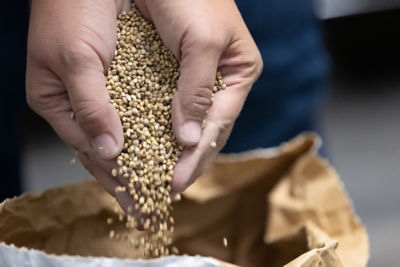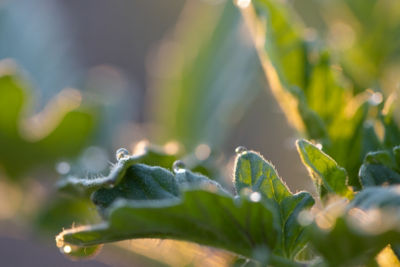Click here to download a PDF version of this spotlight.
» Insect traps can be used to help monitor the presence and populations of vegetable insect pests.
» Several types of traps are available to help monitor important insect pests.
» Growers can use trapping data to help make insect management decisions.
Insect traps are used in commercial vegetable production systems for several purposes, including monitoring the emergence and activity of important pests, timing the application of insecticides based on pest presence or population size, detecting early infestations of new pests, and defining areas of infestation.1,2,3 Traps can vary in design, color, size, and shape. Some traps use pheromone lures or floral scents to increase the sensitivity and selectivity of species captured. Commonly used trap designs include bucket, delta, cone, and sticky card traps.1,2
BUCKET TRAPS
A bucket trap is composed of a bucket that insects can fall into but cannot get out of (Figure 1). These types of traps are capable of capturing large numbers of insects. Often a kill strip or soapy water is placed in the bucket to kill the insects that enter the trap. Specific trap colors and pheromone lures are selected to help attract the target species. One problem with bucket traps is that they can have a high rate of bycatch, the collection of non-target species. Bycatch can take up space that could have been used for the target species, increase the difficulty of sorting and counting the target species, and trap beneficial insects including natural enemies and pollinators.1,2,4
Bucket traps can be used to monitor squash vine borer (SVB) activity.1,5 Bucket traps with SVB pheromone lures attract and trap male SVB moths and, therefore, can help detect the emergence of SVB adults. Some recommendations suggest an action threshold of five moths per week to initiate control procedures for SVB, while others recommend starting applications as soon as SVB moths are detected.1,6
 Figure 1. Various seed coating technologies used for lettuce seed.
Figure 1. Various seed coating technologies used for lettuce seed.
DELTA TRAPS
Delta traps have a “pup tent” (triangular tube) shape that usually has a sticky coating on the inside surface (Figure 2). Pheromone lures are often placed in the trap to attract target species. White colored traps are often used to attract moth species, but other colors of traps are available and used for various target species. These traps are usually suspended in or near the crop canopy.1
Pheromone-baited delta traps are used to monitor tomato pinworm (TPW) presence and activity, especially in high tunnel tomato systems. Traps should be checked at least weekly, and once TPW moths are detected, the crop should be scouted for feeding damage on leaves, stems, and fruit.1

CONE TRAPS
Cone traps have a wide, circular base, narrow towards the top, and are capped by a removable collection chamber or basket (Figure 3). A pheromone lure is usually suspended in the opening at the base of the trap. Insects enter the trap through the bottom opening, fly upward and get caught in the collection chamber, which can be removed to extract the collected insects. Cone traps can be made using wire mesh (hartstack trap) or cloth mesh (Heliothis net trap).1
Corn earworm populations can be monitored in sweet corn fields using pheromone-baited cone traps.7,8 The baited cone traps attract male CEW moths and can provide estimates of the adult populations and egg-laying potential. This information can help growers make decisions on the timing of insecticide application. Pheromone traps should be placed in the field when the first sweet corn crop begins to tassel, or at least by the time fresh silks appear.7,9 The action

threshold for CEW counts depends on the presence of nearby dent (field) corn with fresh silks. If sweet corn is the only corn in the area with fresh silks, an action threshold of one moth per night indicates that an insecticide application may be needed. If silking dent corn is nearby, the action threshold increases to an average of ten moths per night.9,10 Some sweet corn growing regions have established CEW trapping networks to help growers coordinate proper insecticide application times, targeting egg hatch.7,10,11
Cone traps with pheromone lures are also used to monitor squash vine borer (SVB) moths using thresholds similar to those used with bucket traps.1,5
BLACKLIGHT TRAPS
Blacklight traps use a UV light to attract flying insects including moths and beetles. These traps are nonspecific (non-selective) traps attractive to many different insect species. Insects that enter the trap usually collect in a container at the base. These types of traps are useful when no specific attractant like a pheromone is commercially available.12
Blacklight traps are used to monitor corn earworm activity in some areas and used in some regional insect pest monitoring networks.6 However, blacklight traps are more expensive, more difficult to use, and less effective than pheromone baited-cone traps.6,7 Research has also shown that blacklight traps are becoming less effective for monitoring pests such as corn earworm, possibly as a result of increasing levels of light pollution at night.13
STICKY TRAPS
Sticky traps are usually made from cards (three by five inches or larger) that are coated on both sides with a sticky material that traps insects. The cards can be used to indicate the locations and abundance of (mostly flying) insects. However, they are not as accurate or reliable as pheromone baited traps for monitoring pest presence or abundance. Yellow colored sticky traps are used most commonly because the yellow color attracts many kinds of adult flying insects. They are used, especially in greenhouses, to monitor fungus gnats, thrips, whiteflies, aphids, psyllids, and sharpshooters. Sticky cards should be oriented vertically with the bottom edge at or slightly above the top of the crop canopy. The height of the cards should be adjusted regularly as the crop grows. Because these traps are non-selective, both pest and non-pest species can be captured.14
PHEROMONE LURES
A pheromone is a substance that is secreted by one individual that elicits a specific reaction in another individual of the same species.15 Many of the pheromones used as insect lures are sex pheromones that attract male insects. Pheromone lures are usually easy to use, inexpensive, and environmentally benign.3 They are often species-specific and can be used to help monitor pest populations.15 The lures should be stored in sealed glass or foil containers and kept in a refrigerator or freezer before use. When placing pheromone baited traps in the field, the traps should be at least 60 to 120 feet apart to avoid any trap-to-trap interference. Baited traps should be placed on the upwind side of the field so that the pheromone is blown into the field.3
Most pheromones act over a relatively short distance and do not usually lure more pests into the field. One exception to this is the lure for Japanese beetles, which can increase populations of this insect in the area of the trap.1 Lures need to be changed periodically, according to the manufacturer’s recommendations, often every two or three weeks. Lures are available for European corn borer, corn earworm, fall armyworm, squash vine borer, tomato fruitworm, tomato pinworm, eggplant fruit and shoot borer, legume pod borer, cucumber moths, and other insect pests of vegetables.15
SOURCES
1Ingwell, L. 2023. Insects traps as a monitoring tool. Purdue Vegetable Crops Hotline Issue 714.
2Spears, L. R., Looney, C., Ikerd, H., Koch, J. B., Griswold, T., Strange, J. P., and Ramirez, R. A. 2016. Pheromone lure and trap color affects bycatch in agricultural landscapes of Utah. Environmental entomology, 45:1009–1016. https://doi.org/10.1093/ee/nvw085.
3Knodel, J., Petzold, C., and Hoffmann, M. 1995. Pheromone traps - effective tools for monitoring Lepidopterous insect pests of sweet corn. Cornell University, Integrated Pest Management. http://hdl.handle.net/1813/43288.
4 2022. Bucket trap. Entomology Today. https://entomologytoday.org/2022/01/05/beebycatch-advance-ecological-research-collaborations/bucket-trap/.
5Ingwell, L. 2021. Time to scout for squash vine borer (SVB). Purdue University Vegetable Crops Hotline, Issue: 691. https://vegcropshotline.org/article/time-to-scout-for-squash-vine-borer-svb/.
62021. Squash vine borer. UMass Extension Vegetable Program. https://ag.umass.edu/vegetable/fact-sheets/squash-vine-borer.
7Hazzard, R. and Westgate, P. 2005. Organic insect management in sweet corn: Corn earworm. SARE Outreach. SARE Fact Sheet # 01AGI2005. https://www.sare.org/resources/organic-insect-management-in-sweet-corn/.
8Delahaut, K., Cullen, E., and Wedberg, J. Corn earworm. University of Wisconsin Extension publication A3655. https://hort.extension.wisc.edu/articles/corn-earworm/.
9Foster, R. Vegetable insects: Corn earworm. Purdue Extension Entomology. https://extension.entm.purdue.edu/publications/E-31/E-31.html.
10Vegetable insects and their management. Purdue Extension Entomology. https://extension.entm.purdue.edu/veg/cornearworm/.
11Cornell sweet corn pheromone trap network report. https://sweetcorn.nysipm.cornell.edu/.
12Held, D. 2020. Urban landscape entomology, Chapter 5 – Sampling insects and decision making. Academic Press.
13Battles, I., Burkness, E., Crossley, M., Edwards, C., Holmstrom, K., Hutchison, W., Ingerson-Mahar, J., Owens, D., and Owens, A. 2024. Moths are less attracted to light traps than they used to be. Journal of Insect Conservation. https://doi.org/10.1007/s10841-024-00588-x.
14Wilen, C., Koike, S., Ploeg, A., Tjosvold, S., Bethke, J., Mathews, D., Stapleton, J. Revised continuously. Monitoring with sticky traps. UC IPM pest management guidelines: Floriculture and ornamental nurseries. UC ANR Publication 3392. https://ipm.ucanr.edu/agriculture/floriculture-and-ornamental-nurseries/monitoring-with-sticky-traps/#gsc.tab=0.
15Srinivasan, R., Lin, M., Su, F., Yule, S., Khumsuwan, C., Hien, T., Hai, V., Khanh L., and Bhanu K. 2015. Use of insect pheromones in vegetable pest management: Successes and struggles. In Chakravarthy, A. (ed) New horizons in insect science: Towards sustainable pest management. Springer, New Delhi. https://doi.org/10.1007/978-81-322-2089-3_21.
Websites verified 9/27/2024
ADDITIONAL INFORMATION
For additional agronomic information, please contact your local seed representative.
Performance may vary, from location to location and from year to year, as local growing, soil and environmental conditions may vary. Growers should evaluate data from multiple locations and years whenever possible and should consider the impacts of these conditions on their growing environment. The recommendations in this article are based upon information obtained from the cited sources and should be used as a quick reference for information about vegetable production. The content of this article should not be substituted for the professional opinion of a producer, grower, agronomist, pathologist and similar professional dealing with vegetable crops.
BAYER GROUP DOES NOT WARRANT THE ACCURACY OF ANY INFORMATION OR TECHNICAL ADVICE PROVIDED HEREIN AND DISCLAIMS ALL LIABILITY FOR ANY CLAIM INVOLVING SUCH INFORMATION OR ADVICE.
5051_454652 Published 09/27/2024




